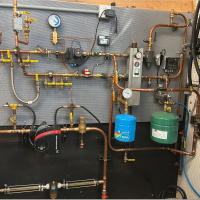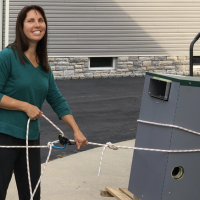Best Of
Re: Buffer Tank glass-lined vs stainless, sizing
It doesn't take a lot of tank to hold hydronic pressure and temperature. An expansion tank for example is sheetmetal.
I built a solar drainback tank from a Harbor Freight air tank.
Heck a .11 mm aluminum Coke can, about the thickness of a human hair, can hold 90 psi!
 hot_rod
hot_rod
Re: Buffer Tank glass-lined vs stainless, sizing
For longevity I would lean toward glass line . Stainless tank makes sense . Welding stainless is difficult which , Which brings up the percentage of an issue …
 Big Ed_4
Big Ed_4
Re: Buffer Tank glass-lined vs stainless, sizing
Make the size increase short and close to the tank. You get a slight velocity increase through the increaser.
I've taken 3/4 to 1-1/4" on tanks 12- 14 gpm possible.
Here are the fittings I have used on HW tanks.
3/4 mip to 1-1/4 copper adapter use on the water connections
3/4 x 1-1/2 stainless bell
1" mip x 1-1/4 copper use for the element holes
1X 1-1/4 brass swage nipple
Swage nipples were used in Munchkins as their header was 1" connection. So some were 1X 1-1/4 and some actually were 1 X 1-1/2" nipples! I think the 199,000 had the 1X 1-1/2 swage nipples
On this 6 gallon tank, the 3/4 water connections are increased to 1-1/4 for the LLH function
Stainless tanks? How are your chloride levels?
Glass lined seem to be able to handle most any water condition. Keep them under 180°F. High temperature, thermal stress, is a killer on glass DHW tanks.
 hot_rod
hot_rod
Re: Air to Water Heatpump scenario for my abode.
The way the model works is if I put in any point on the load curve there it will calculate the rest of the values. (It assumes a straight line).
Re: Thanks for everyone's help, it's finally installed
Thanks @mattmia2 and @EricPeterson
I agree that it seems to perform great for that purpose the temp at the boiler gets up pretty quickly and as it gradually opens to full flow it avoids any shocks due to the big temp difference coming down from the radiators. I agree that it seems like a small investment in an insurance policy that protects the most important piece of the system.
Thanks Again
Re: Air to Water Heatpump scenario for my abode.
OK, here's my whack at an analysis:
From your prices of gas and electricity I get the break-even COP at 3.36, which is what the heat pump gives at 52F. That's basically a deal-breaker for the heat pump, there's almost no usage above 52F. Running all-gas is $738.21for the heating season, a heat pump would cost you $220.02 more. (That seems really cheap to me, I guess I'm used to east coast prices.)
I didn't bother doing any of the analysis for things like split fuel, it's just not going to be worthwhile. A bigger heat pump would reduce the amount of backup heat use but that's only 8% of the total and not going to change the picture.
Re: Low water in sight glass & missing main vents (balancing issues)
You skim the boiler. Oils in the boiler cause it to foam and throw the water into the pipes. After the oils are removed, it will produce steam with minimal change to the water line.
Of course you have other issues at play with your piping, but hopefully your installer will address that.
New pipes have oil in and on them so if they install new pipes, that will make more oil that needs to be skimmed out.
here is another video. In this one, I added oil purposely to my new boiler to demonstrate what happens:
Re: Return changes elevation and other oddities.
Ultimately I'm trying to identify what work will have the greatest impact on fuel burn and heat output for the least upfront cost. The 90 year old owner of the property has just had to spring for a new boiler and near boiler piping, chimney liner, feed tank etc. He's horrified by how much he's spent already, knows as much about his heating system as my dog knows about bitcoin and justifying each additional dollar is tricky.
We're in St. John's Newfoundland, 5 miles from the most easterly point in north America. There's nobody on this little island that knows anything about steam heating.
The struggle is real folks and I appreciate all the advice.

